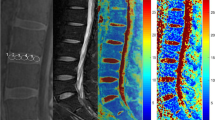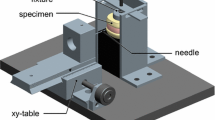Abstract
Objectives
To assess feasibility of a three-dimensional ultrashort echo time (3D-UTE)-sequence to evaluate normal and pathological disco-vertebral complex (DVC), with assessment of its different portions in a rat model of degenerative disk disease (DDD) with histological correlation. To assess whether this sequence, in comparison with long echo time T2-weighted sequence, is able to monitor DDD with differentiation of early from chronic DVC changes in pathological mechanical conditions.
Methods
Five rats were induced with DDD model by percutaneous disk trituration of the tail with an 18-G needle under US-guidance and imaged at 4.7 T. MRI protocol included fat-saturated-T2 (RARE) and 3D-UTE-sequences performed at baseline (day 0. n = 5 animals /10 DVC) and each week (W) from W1 to W10 postoperatively. Visual analysis and signal intensity measurements of SNR and CNR of all DVC portions were performed on RARE and UTE images. Following killing (baseline, n = 1/2 DVC; W2, n = 2/4 DVC; W10, n = 2/4 DVC), histological analysis was performed and compared with MRI.
Results
In normal DVC, unlike conventional RARE-sequences, 3D-UTE allowed complete identification of DVC zonal anatomy including on visual analysis and CNR measurements. In pathological conditions, SNR and CNR measurements of the annulus fibrosus and nucleus pulposus on 3D-UTE distinguished early discitis at W1 from chronic discopathy (P < 0.001 for SNR and P < 0.001 for CNR). Neither the normal complete anatomy of the DVC nor its pathological patterns could be assessed on conventional sequences.
Conclusions
Unlike conventional sequences, 3D-UTE enables visualization of the complete normal DVC anatomy and enables monitoring of DDD differentiating between early DVC changes from chronic ones.
Level of evidence I
Diagnostic: individual cross-sectional studies with the consistently applied reference standard and blinding.







Similar content being viewed by others
References
Du J, Bydder M, Takahashi AM, Chung CB (2008) Two-dimensional ultrashort echo time imaging using a spiral trajectory. Magn Reson Imag 26:304–312
Du J, Takahashi AM, Bae WC, Chung CB, Bydder GM (2010) Dual inversion recovery, ultrashort echo time (DIR UTE) imaging: creating high contrast for short-T2 species. Magn Reson Med 63:447–455
Gatehouse PD, Bydder GM (2003) Magnetic resonance imaging of short T2 structures in tissue. Clin Radiol 58:1–19
Henkelman RM, Stanisz GJ, Graham SJ (2001) Magnetization transfer in MRI: a review. NMR Biomed 14:57–64
Pfirrmann CW, Metzdorf A, Zanetti M, Hodler J, Boos N (2001) Magnetic resonance classification of lumbar intervertebral disc degeneration. Spine (Phila Pa 1976) 26(17):1873–1878
Moon SM, Yoder JH, Wright AC, Smith LJ, Vresilovic EJ, Elliott DM (2013) Evaluation of intervertebral disc cartilaginous endplate structure using magnetic resonance imaging. Eur Spine J 22(8):1820–1828
Cao Y, Liao S, Zeng H, Ni S et al (2017) 3D characterization of morphological changes in the intervertebral disc and endplate during aging: a propagation phase contrast synchrotron micro-tomography study. Sci Rep 7:43094
Gruber HE et al (2005) Vertebral endplate architecture and vascularization: application of micro-computerized tomography, a vascular tracer, and immunocytochemistry in analyses of disc degeneration in the aging sand rat. Spine (Phila Pa 1976) 30:2593–2600
Chen KC, Tran B, Biswas R, Statum S, Masuda K, Chung CB et al (2016) Evaluation of the disco-vertebral junction using ultrashort time-to-echo magnetic resonance imaging: inter-reader agreement and association with vertebral endplate lesions. Skeletal Radiol 45(9):1249–1256
Bae WC, Statum S, Zhang Z, Yamaguchi T, Wolfson T, Gamst AC, Du J, Bydder GM, Masuda K, Chung CB (2013) Morphology of the cartilaginous endplates in human intervertebral disks with ultrashort echo time MR imaging. Radiology 266(2):564–574
Berg-Johansen B, Han M, Fields AJ, Liebenberg EC, Lim BJ, Larson PE, Gunduz-Demir C, Kazakia GJ, Krug R, Lotz JC (2018) Cartilage endplate thickness variation measured by ultrashort echo-time MRI Is associated with adjacent disc degeneration. Spine (Phila Pa 1976) 43(10):E592–E600
Kim YJ, Cha JG, Shin YS, Chaudhari AS, Suh YJ, Hwan Yoon S, Gold GE (2018) 3D ultrashort TE MRI for evaluation of cartilaginous endplate of cervical disk in vivo: feasibility and correlation with disk degeneration in T2-weighted spin-echo sequence. AJR Am J Roentgenol 210(5):1131–1140
Bierry G, Jehl F, Boehm N, Robert P, Dietemann JL, Kremer S (2009) Macrophage imaging by USPIO-enhanced MR for the differentiation of infectious osteomyelitis and aseptic vertebral inflammation. Eur Radiol 19(7):1604–1611
Hirata H, Yurube T, Kakutani K, Maeno K, Takada T, Yamamoto J et al (2014) A rat tail temporary static compression model reproduces different stages of intervertebral disc degeneration with decreased notochordal cell phenotype. J Orthop Res 32(3):455–463
Fernández-Susavila H, Pardo-Seco JP, Iglesias-Rey R, Sobrino T, Campos F, Díez-Ulloa MA (2017) Model of disc degeneration in rat tail induced through a vascular isolation of vertebral endplates. J Invest Surg 25:1–10
Georgy M, Stern M, Murphy K (2017) What Is the role of the bacterium propionibacterium acnes in type 1 modic changes? A review of the literature. Can Assoc Radiol J 68(4):419–424
Miraux S, Massot P, Ribot EJ, Franconi JM, Thiaudiere E (2008) 3D true FISP imaging of mouse brain at 4.7T and 9.4T. J Magn Reson Imag 28(2):497–503
Constantinides D, Atalar E, McVeigh ER (1997) Signal-to-noise measurements in magnitude images from NMR phased arrays. Magn Reson Med 38(5):852–857
Roberts S, Evans H, Trivedi J, Menage J (2006) Histology and pathology of the human intervertebral disc. J Bone Joint Surg Am 88(Suppl 2):10–14
Böker SM, Bender YY, Adams LC, Fallenberg EM, Wagner M, Hamm B et al (2017) Evaluation of sclerosis in Modic changes of the spine using susceptibility-weighted magnetic resonance imaging. Eur J Radiol 88:148–154
Bae WC, Statum S, Zhang Z et al (2013) Morphology of the cartilaginous endplates in human intervertebral disks with ultrashort echo time MR imaging. Radiology 266(2):564–574
Crockett MT, Kelly BS, van Baarsel S, Kavanagh EC (2017) Modic type 1 vertebral endplate changes: injury, inflammation, or infection? AJR Am J Roentgenol 209(1):167–170
Ulrich JA, Liebenberg EC, Thuillier DU et al (2007) ISSLS prize winner: repeated disc injury causes persistent inflammation. Spine (Phila Pa 1976) 32:2812–2819
Roberts S, Menage J, Urban JPG (1989) Biomechanical and structural properties of the catilage end-plate and its relation to the intervertebral disc. Spine 14:166–174
Wang Y, Battie MC, Boyd SK, Videman T (2011) The osseous endplates in lumbar vertebrae: thickness, bone mineral density and their associations with age and disk degeneration. Bone 48:804–809
Funding
None.
Author information
Authors and Affiliations
Corresponding author
Ethics declarations
Conflict of interest
The authors declare that they have no conflict of interest.
Additional information
Publisher's Note
Springer Nature remains neutral with regard to jurisdictional claims in published maps and institutional affiliations.
Rights and permissions
About this article
Cite this article
Dallaudière, B., Ribot, E.J., Trotier, A.J. et al. Three-dimensional ultrashort echo time (3D UTE) magnetic resonance imaging (MRI) of the normal and degenerative disco-vertebral complex at 4.7 T: a feasibility study with longitudinal evaluation. Eur Spine J 30, 1144–1154 (2021). https://doi.org/10.1007/s00586-021-06755-x
Received:
Revised:
Accepted:
Published:
Issue Date:
DOI: https://doi.org/10.1007/s00586-021-06755-x




